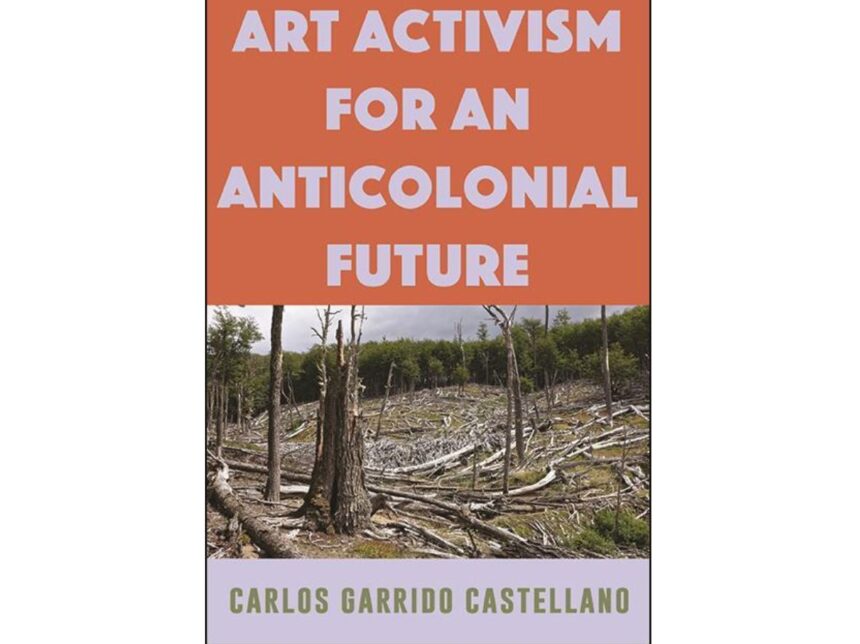Book Review: Art Activism for an Anticolonial Future, by Carlos Garrido Castellano (Albany: State University of New York Press, 2021)
Noni Brynjolson
In Art Activism for an Anticolonial Future, Carlos Garrido Castellano provides a valuable resource for scholars of socially engaged art, and for contemporary art theory and criticism more broadly. The book explores numerous examples of socially engaged art that have taken place outside of western art institutions and networks. This on its own is a major contribution, and something that has been lacking in discourse on contemporary socially engaged art. The book does a major service for these missing histories, demonstrating that socially engaged art is not solely a western phenomenon—both in terms of contemporary art and pre-modern cultural practices and traditions. In this way, the works examined here can be seen as expanding an already existing canon of socially engaged art and offering rich case studies that give readers a look at how anticolonial efforts have played out in a number of different contexts.
While expanding the canon is valuable, the book goes further and takes apart some of the central myths and origin stories associated with collaborative and community-based art. Garrido Castellano refers to this approach as “undisciplining socially engaged art,” an intriguing concept that is unpacked in a great amount of detail. One of the central arguments being explored here is that this type of work should not be evaluated based on purely western criteria, using sources drawn from the western canon of art, aesthetic philosophy and criticism. Instead, we need new touchstones for understanding how such practices emerge in relation to specific places, histories and contexts, outside of western institutions and narratives. The book provides a starting point for building these frameworks, by engaging with a range of thinkers associated with postcolonial theory, and by thoroughly exploring collaborative practices linked to different anticolonial movements. He points out that they share much in common, writing that “socially engaged forms of art linked to anticolonial causes present a complex and decades-old genealogy, whose evolution informs an alternative history of global artistic interactions.”[1] According to this argument, socially engaged art should not be viewed as a “new” mode of artistic practice that emerged recently in western contexts. Instead, as he demonstrates, collaborative art has played a key role in art of the Global South, and in anticolonial activism around the world.
Art Activism for an Anticolonial Future is divided into four parts, and Garrido Castellano begins by looking at the emergence of art biennials as the main spaces in which art has become global. While this has resulted in more non-western artists gaining attention for their work, it has also involved a close alignment between art and capital, a growing emphasis on individualism, and the prioritization of specific forms of art that often adhere to western conventions. This is the problem with the “expanding the canon model”—problematic structures are left untouched and are free to replicate. The rise of global biennials, and the kind of work they promote, has come at the expense of alternative forms of art making that exist outside of this framework. As Garrido Castellano points out, this has the effect of “limiting the visibility of creative forms such as socially engaged art, art activism, and alternative institutionalism, where issues of cultural labor and cultural capital are particularly evident.”[2] Looking at alternatives to these spectacles, he highlights the presence of what he refers to as “under-the-radar” collaboration and collectivism. He points to the Trinidadian space Alice Yard as an example, a collective that operates in Port of Spain and hosts artist residencies, performances and events inspired by the tradition involving shared urban yard spaces.[3] It is an interesting example that illustrates the main points covered in the book very well, since it involves forms of local cultural production tied to specific histories of collectivism. However, it also speaks to the issue of seeking out alternatives to the mainstream art world: in 2022, Alice Yard was included in documenta fifteen—one of the least under-the-radar art events in the world. Bringing their model of collectivism to Kassel, Germany, the group’s contributions involved hosting conversations, screenings, events and “spontaneous activations” throughout the run of the mega exhibition.[4]
This example speaks to the tradeoffs, negotiations and refusals that take place between western and non-western practices—blurring the lines between these two categories and complicating understandings of aesthetic canons and their alternatives. This is also evident in Garrido Castellano’s discussion of the lexicon of socially engaged art. He rejects historical accounts that position this type of work as a product of western discourses on art and aesthetic theory, one example being Claire Bishop’s Artificial Hells: Participatory Art and the Politics of Spectatorship (London: Verso, 2012). Garrido Castellano argues that relying upon such genealogies for participatory art, as Bishop does, “depends on an aesthetic judgment grounded on avant-gardist traditions.”[5] Instead, he looks elsewhere, first pointing to other histories and theories of socially engaged art that have foregrounded issues of racial and cultural identity at the heart of collaboration, including writing by Suzanne Lacy and Nina Felshin.[6] This can be seen as part of an expanding discourse on this type of work that seeks to move away from western aesthetic theory and influence and find new sources of knowledge and theory production. Some scholars have pointed to influences for socially engaged art practices coming from the civil rights movement, for example,[7] or models of political solidarity found in Latin American social movements.[8]
In a recent article by Gregory Sholette, he sums up the dilemma facing art historians writing about this type of work and its historical genealogies, referring to this as the “Courbet Conundrum.” It is not surprising that many of us return to models associated with the western avant-garde, and to influential individuals like Gustave Courbet who brought aesthetics and politics together in their work. Yet, as Sholette points out, in creating a genealogy for interpreting collective modes of cultural production, historical events operating outside of western contexts need to be given more weight. We are familiar with the modes of artistic production that came out of the Russian Revolution, for example, and how this inspired later forms of socially engaged art, but what about the Haitian Revolution?[9] (A major aim of FIELD has, in fact, been to highlight socially engaged art in a global context, not just to expand the canon, but to find new ways of interpreting and writing about this type of work that account for its embeddedness in specific cultural traditions and networks of resistance).[10]
In alignment with these ideas and aims, Garrido Castellano looks to a number of key thinkers who have written from anticolonial perspectives. In chapter three, he reflects on the work of revolutionary writer and activist Amílcar Cabral, examining how it brings together theory and practice and emphasizes bottom-up action in solidarity movements. His writing and ideas provide a source for scholars and practitioners of socially engaged art to draw from, since as Garrido Castellano argues, his “interest in experience-based research and collaborative knowledge makes him a precursor of many of the projects and initiatives this book analyzes.”[11] The next chapter looks at what Garrido Castellano refers to as a “missed encounter” between German theorist Theodor Adorno and C.L.R. James, the Trinidadian writer and anticolonial activist. It is referred to in this way because of the suggestion that a deeper engagement between the two could have strengthened both the critical theory of the Frankfurt School and the Black Marxist theory associated with James. In looking more closely at James’s writings, Garrido Castellano makes a case for his relevance for theories of socially engaged art, pointing to James’s emphasis on collective agency, improvisation, and engagement with popular culture—a set of values that differs greatly from those of Adorno.
In parts three and four of the book, Garrido Castellano explores case studies in Uganda, Indonesia, Beirut, Chile, Brazil and Portugal. These were fascinating to read, first of all because of the lack of research on socially engaged art practices in these places. Looking at these examples also offers ways to understand the particularities of collaborative practice. He looks at two projects in Uganda, one involving soap sculptures made by artist Lilian Mary Nabulime meant to create awareness of HIV/AIDS in rural areas, which she viewed as tools for communication and dialogue. Another project, initiated by artist Fred Batale, involved forming an organization called the Disability Art Project Uganda that helped to modify motorbikes called boda bodas to accommodate people with impaired mobility. Garrido Castellano locates the transformative potential of such projects in the social exchanges that they make possible, and in their commitment to long-term collaboration, which contrasts with the temporary initiatives associated with biennials and other large-scale cultural festivals. Importantly, the goal with these projects is “not to ‘help’ individuals but to articulate individual and collective action in effective and innovative ways.”[12]
Other chapters provide similar insight into the specific ways in which collectivism and collaboration emerge in artistic practices aligned with anticolonial aims. For example, Garrido Castellano looks at longstanding traditions of collectivism in Indonesian art and examines how this challenged the move towards individualism normalized during the Suharto era. During this time there was an intensification of neoliberal economic policies, which was reflected in the Indonesian art scene. A small number of individual artists gained international attention while the vast majority remained anonymous, and as Garrido Castellano points out, “even lost its capacity to buy basic painting resources such as canvases and paint.”[13] There were a number of art collectives considered in this chapter, but the one that might draw the most interest from readers today is ruangrupa—the group at the center of the recent documenta controversy due to unfounded allegations of anti-semitism, based on their support of Palestinian artists and the BDS movement.[14]
The discussion of their work in Art Activism for an Anticolonial Future focuses on the formation of the collective in 2000 and looks at how they operated as an informal institution, supporting each other’s practices as an alternative to the art market and the growing bureaucratization of cultural production in Jakarta. Comparing their work with other examples, Garrido Castellano writes that it may be viewed as “the result of a complex negotiation with global influences and a home-brewed tradition of social criticism through art spanning across the history of twentieth-century Indonesian politics.”[15] Looking at examples in Indonesia, he shows how collaborative art practices can function as platforms for engaging audiences in processes of social transformation, similar to the Uganda projects discussed earlier. These examples also help illuminate the ways in which socially engaged art works to “revitalize past emancipatory actions in new and unexpected ways,” as he puts it.[16]
Subsequent chapters explore initiatives such as Temporary Art Platform, an organization that produces site-specific public art projects in Beirut, and Ensayos, an educational and research platform in Chile examined in relation to Tania Bruguera’s concept of arte útil. A fascinating final chapter focuses on alt-right groups in Brazil and Portugal, and Garrido Castellano looks at the rise of public controversies surrounding cultural events in recent years—for example, the controversy over a talk by Judith Butler at the University of São Paulo in 2017. Alt-right groups protested the event and burnt a witch-like effigy of Butler in the street, due to her support of so-called ideologia de gênero (gender ideology), which they viewed as an attack on traditional values such as marriage and heteronormativity. Garrido Castellano connects this action and others like it with an increase in violence and violent rhetoric against left-wing activists in Brazil. However, he also points out that such episodes are proof that art and progressive criticism are more relevant and meaningful than ever, since so much conservative rage has been directed against them.[17] This is a fascinating observation, and there are parallels with Black Lives Matter activism, which Garrido Castellano examines in a short “open coda” section at the end of the book.
In each of these chapters, the author provides detailed discussions of the history and politics of each place, and the forms of anticolonial activism that have emerged there. While this is necessary for readers in order to fully engage with the case studies being analyzed, it also speaks to the challenges of producing such a wide-ranging global account of socially engaged art—the sheer amount of background information can feel overwhelming. I found myself at times wanting more comparative links between chapters, and connective threads that would lead me back to the alternative theoretical frameworks outlined in earlier sections. I also wondered about the impact of these practices. Many of these artists discussed in the book were able to engage in creative expression with others through their work, or bring awareness to social issues, or form networks of solidarity with other artists, yet I was curious to know more about how they actually shaped the form or direction of various kinds of anticolonial activism—especially after reading the last chapter. In the face of alt-right groups and authoritarian movements, and the immense structural powers of neoliberal capitalism, how are these projects actually having an impact on the future?
The book leaves certain big questions unanswered. However, what it does speak volumes about is the fact that socially engaged art must not be seen as a recent phenomenon, or a western product. In addition to helping to decolonize canons of art history by adding numerous examples of non-western socially engaged art, Garrido Castellano shows how its key features, including collaboration, collectivism, informality, spontaneity and dialogue, are not concepts that need to be understood in the context of the western avant-garde. Art Activism for an Anticolonial Future offers a rich set of resources for scholars and opens the door for more research to follow.
Noni Brynjolson is an art historian who studies collaborative public art projects. Her research analyzes large-scale, long-term works in which artists address the politics of housing and neighborhood redevelopment through forms of cultural production and community organizing. She is an Assistant Professor of Art History at the University of Indianapolis.
Notes
[1] Carlos Garrido Castellano, Art Activism for an Anticolonial Future (Albany: State University of New York Press, 2021, p. 30.
[2] Garrido Castellano, p. 27.
[3] Alice Yard website, http://aliceyard.blogspot.com/, accessed 18 October 2022.
[4] Alice Yard, documenta fifteen website, https://documenta-fifteen.de/en/lumbung-members-artists/alice-yard/, accessed October 15, 2022.
[5] Garrido Castellano, p. 68.
[6] Examples include Suzanne Lacy, Mapping the Terrain: New Genre Public Art (Seattle: Bay Press, 1994), and Nina Felshin, But Is It Art?: The Spirit of Art as Activism (Seattle: Bay Press, 1994).
[7] For example, see Tom Finkelpearl, What We Made: Conversations on Art and Social Cooperation (Durham: Duke University Press, 2013).
[8] For example, see Bill Kelley Jr. and Grant Kester, eds., Collective Situations: Readings in Contemporary Latin American Art, 1995-2010 (Durham: Duke University Press, 2017).
[9] Gregory Sholette, “The Courbet Conundrum: Back Stories of Contemporary Activist Art,” 7 July 2021, https://gregsholette.tumblr.com/post/656057584277651456/the-courbet-conundrum-back-stories-of, accessed 15 October 2022.
[10] See FIELD’s special issues on socially engaged art in Iran (Issue 21), Africa (Issue 17), Japan (Issues 7 and 8), and a special issue on Art, Anti-Globalism and the Neo-Authoritarian Turn (Issues 12/13).
[11] Garrido Castellano, p. 105.
[12] Garrido Castellano, p. 158.
[13] Garrido Castellano, p. 172.
[14] “documenta artists condemn racist attacks following vandalism,” Artforum, 6 June 2022, https://www.artforum.com/news/documenta-artists-condemn-racist-attacks-following-vandalism-88717, accessed 15 October 2022.
[15] Garrido Castellano, p. 198.
[16] Garrido Castellano, p. 196.
[17] Garrido Castellano, p. 261.







